Policies
Writing and editing policies
title: Writing and editing policies description: Learn how to write, edit and format policy documents in the Policy Center of Tidal Control sidebar_position: 2
Using the Policy Editor
The Policy Editor is our built-in editor that allows you to create and edit professional policy documents. When you choose "Create with policy editor", you'll be taken to the editor.
First steps in the editor
Initially, the editor is loaded with a standard template that gives you a good starting point:
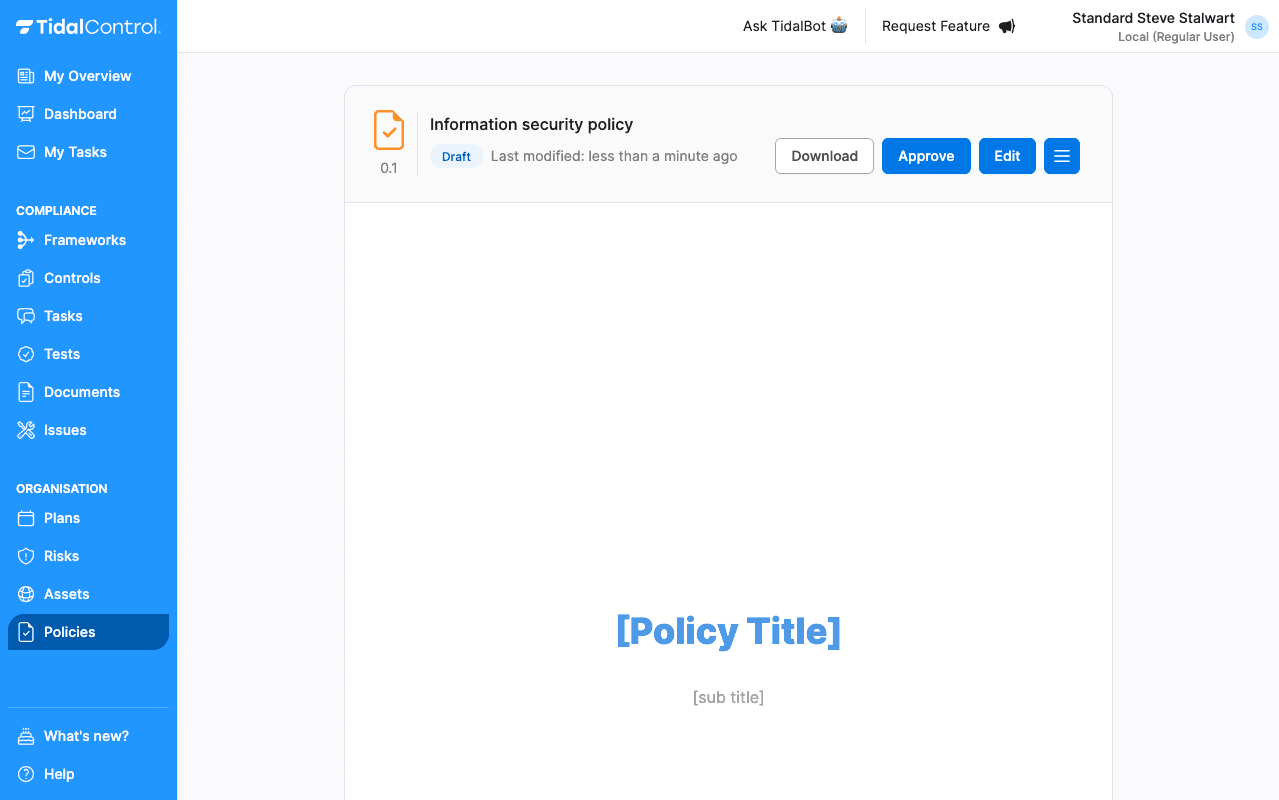
In the editor you see:
- Policy title - Automatically filled in based on your policy
- Document status - Approved or Draft
- Policy version number - For version control
- Document content - Your actual policy text
- Action buttons - For editing, approving, downloading etc.
- Menu button (three horizontal lines) - Opens the sidebar with more information and version history
When you first open the editor, you are in view mode. The document can only be edited after you click the "Edit" button.
Editing documents
When you click the "Edit" button, the editor toolbar appears with all editing capabilities:
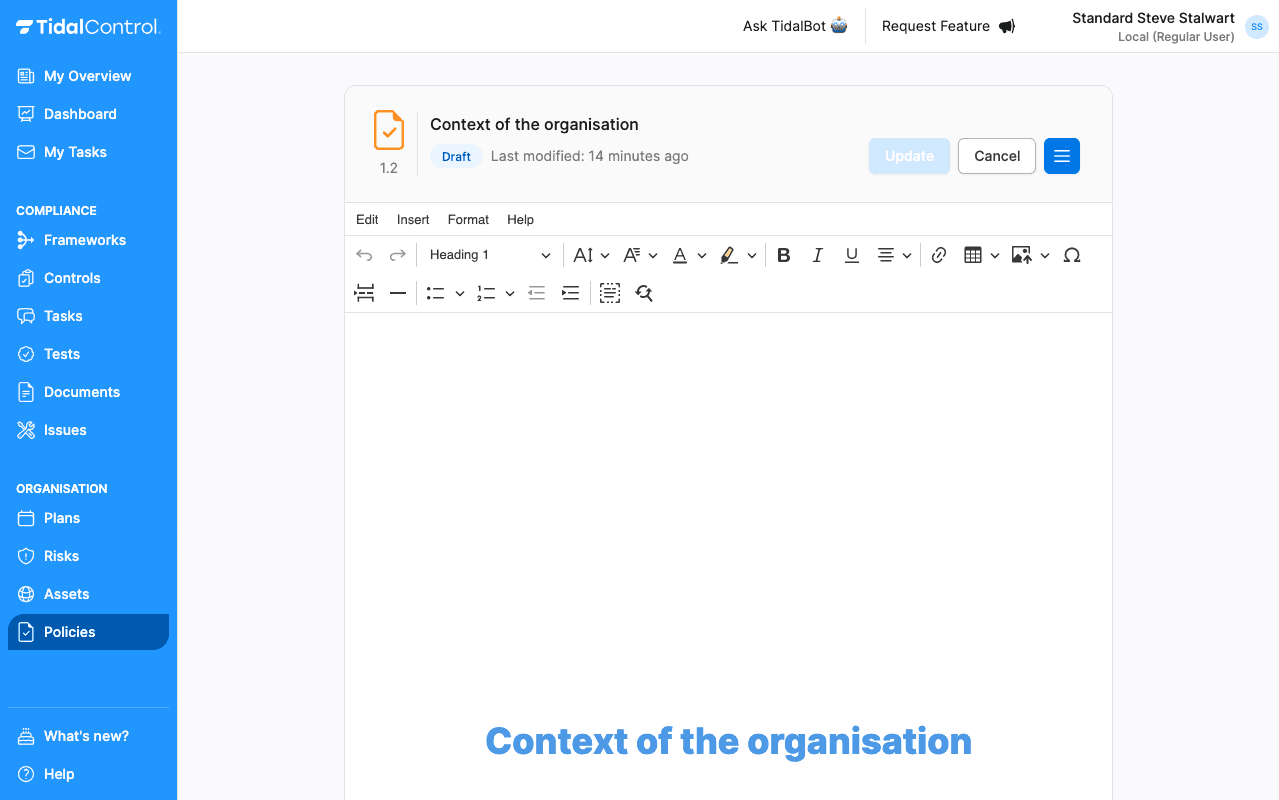
The editor contains a complete set of word processing functionalities:
- Text formatting - Bold, italic, underlined
- Lists - Numbered and bullet points
- Headings - Different levels for structure
- Tables - For structured information
- Links - To external sources or internal documents
- Images - For visual support
Some options are not visible in the toolbar but can be found in the menu bar. Explore the different menus to discover all functionalities.
Templates and structure
Standard template
The standard template contains typical sections for policy documents:
- Purpose and scope - Why does this policy exist?
- Responsibilities - Who does what?
- Procedures - How is the policy applied?
- Compliance and monitoring - How is compliance controlled?
Creating your own structure
You are not bound to the standard template. You can:
- Add or remove sections
- Create your own heading structure
- Add specific content that fits your organization
Watch out with approved policies! When you click "Edit" in an approved policy, a new draft is automatically created with the same content as the approved document.
The current approved document will only be replaced on the main page when you approve this new draft.
Uploading existing documents
Upload process
When you choose "Upload file from your computer", you get an upload interface:
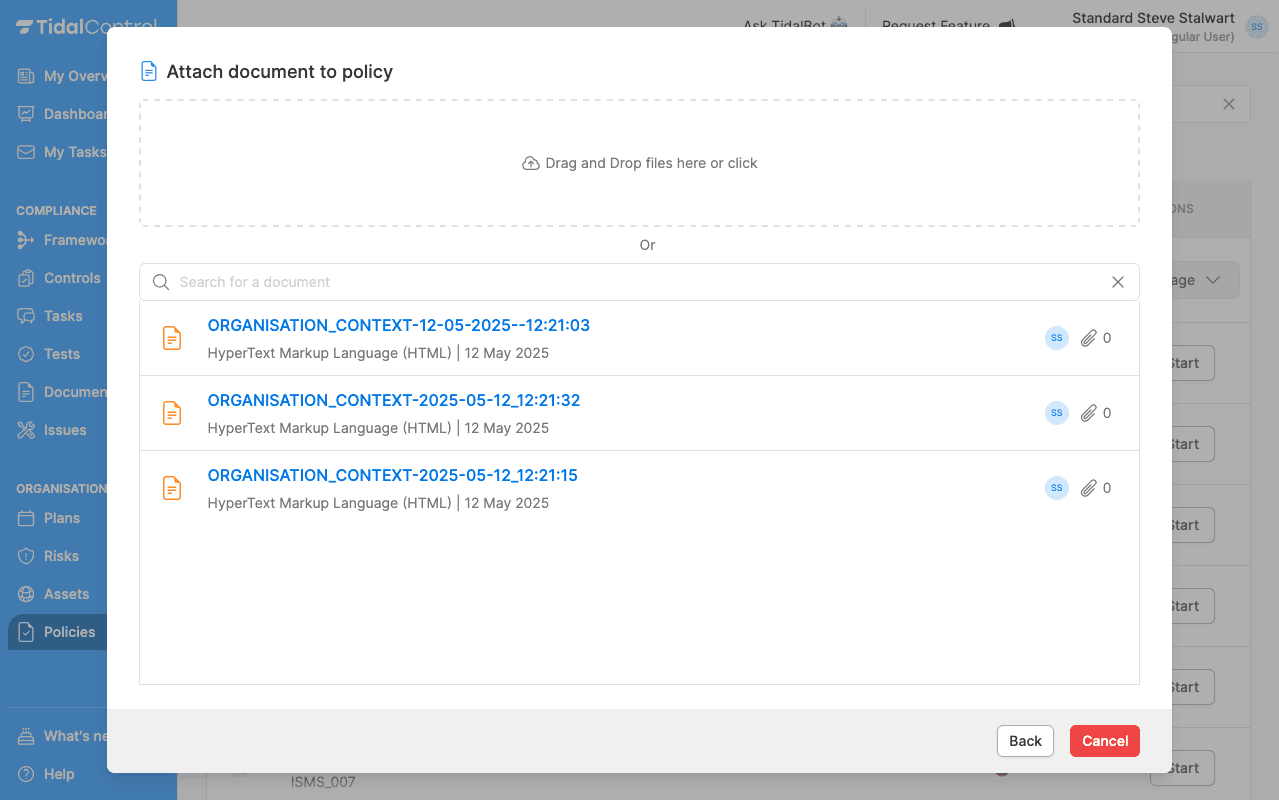
You can upload files by:
- Drag & Drop - Drag files directly to the upload box
- Click - Opens a new File Explorer selection screen
- Search for a document - Select a document that is already in Tidal
Supported file formats:
- PDF documents
- Microsoft Word documents (.doc, .docx)
- Microsoft Excel documents (.xls, .xlsx)
- ...and many more
Upload management
After upload, you see in the overview that uploaded files are recognizable by the paperclip icon:
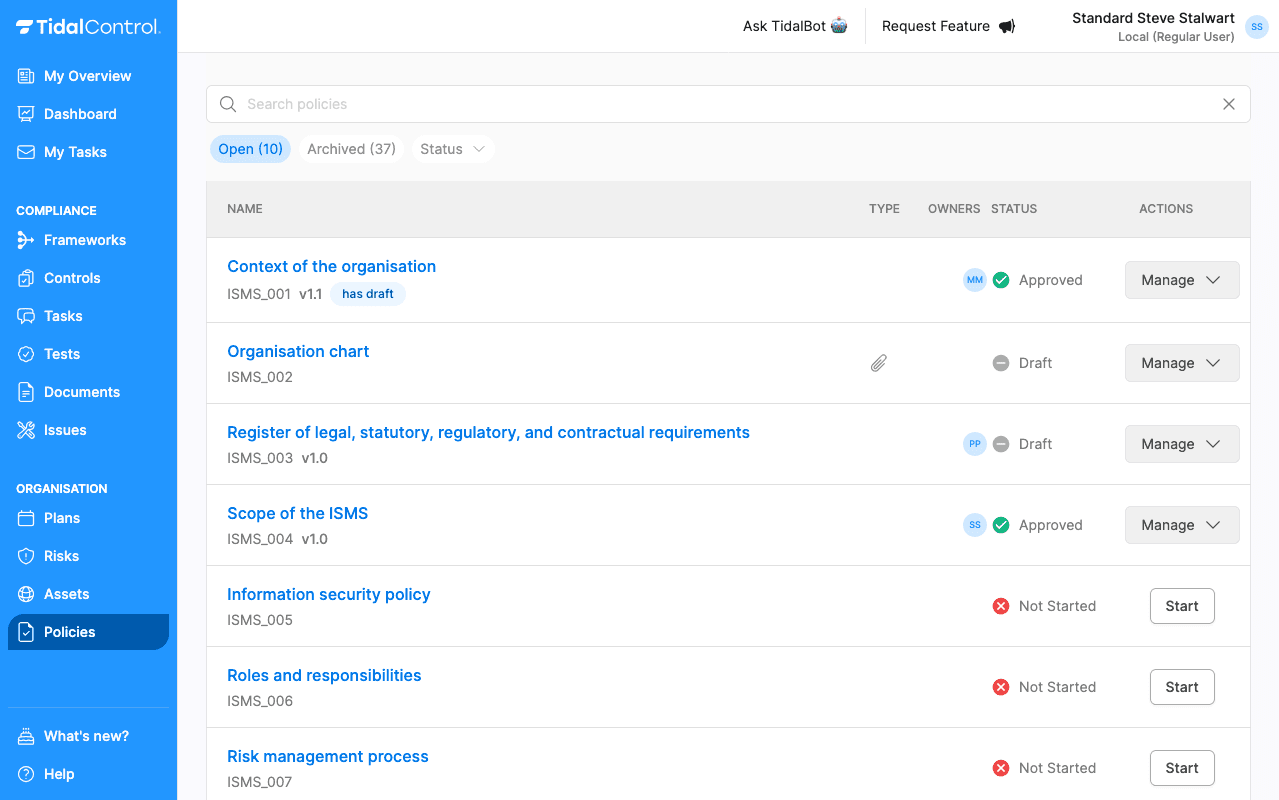
Uploading new versions
When you have a new version of your document ready:
- Go to the "Manage" menu of the policy
- Click on "Upload other file"
- Upload your new file
When uploading a new version, the approval status is automatically reset. Your new document has "Draft" status and must be approved again.
Advantages and limitations
Advantages of uploaded documents:
- Maintain your current workflows and templates
- No retraining of your team needed
- Familiar software and formatting options
Limitations:
- Limited editing capabilities within Tidal
- Manual version management
- No integrated collaboration features
Linking external policies
URL-based management
For organizations that manage their policy documents elsewhere, Tidal offers the possibility to link external URLs:
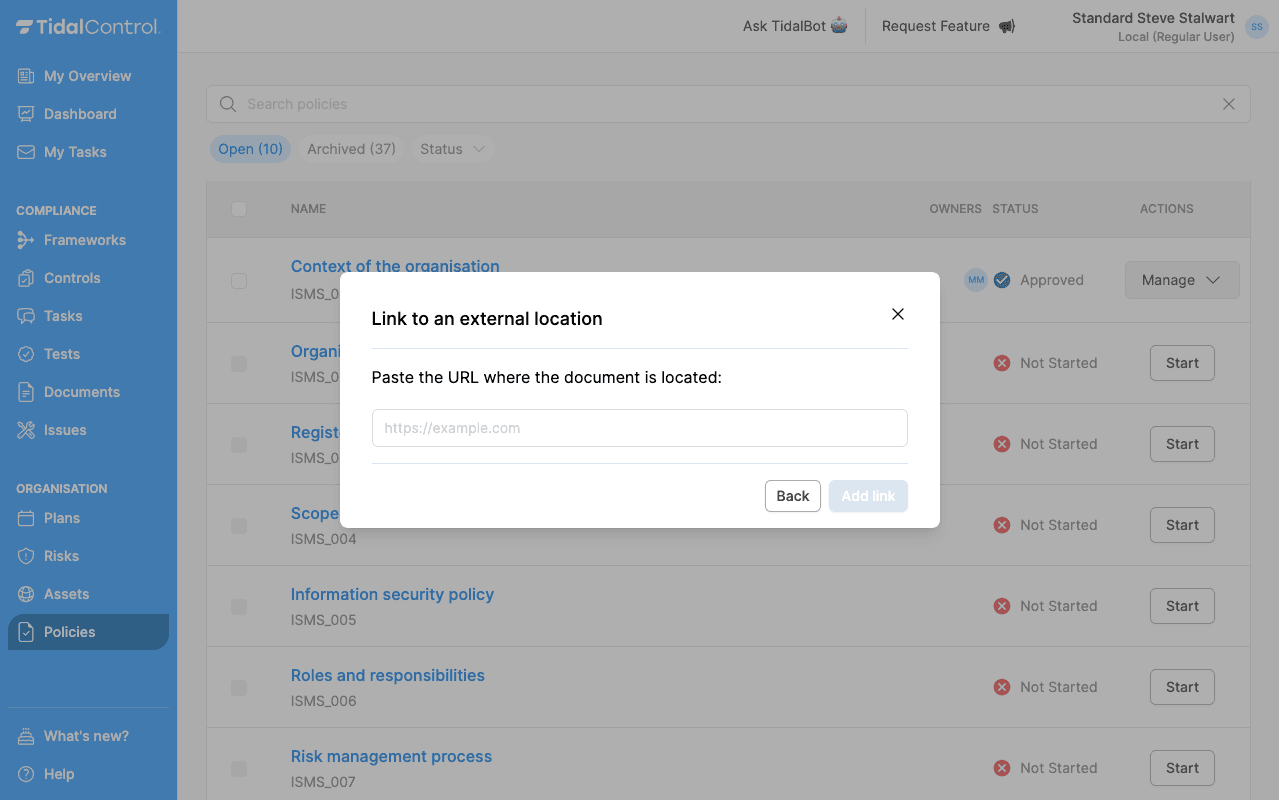
Setup process
- Choose "Link to an external location" in the start menu
- Enter the URL of your external policy document
- Click "Add link" to save the url
URL management
The URL is stored in a file within Tidal, allowing you to still use:
- Approval workflows
- Review cycles
- Compliance tracking
Version history in Tidal for external policies: You can still maintain version history within Tidal by manually editing the URL in the policy editor when a new version is available.
Best practices for external policies
Documentation:
- Keep track of which URL refers to which version, or;
- Ensure stable URLs that don't change
Accessibility:
- Check that URLs are accessible to all relevant users
- Set proper permissions in your external system
- Test links regularly for validity
Externally managed policies are not indexed in Tidal, so their content is not known to our AI assistance.
Content formatting and styling
Structuring text
Effective heading structure
Use a logical hierarchy of headings:
- H1 - Chapter titles
- H2 - Section titles
- H3 - Paragraph titles
Lists and enumerations
- Bullet points for unordered items
- Numbered lists for procedures and steps
- Nested lists for hierarchical information
Using tables
Tables are ideal for:
- Roles and responsibilities overviews
- Procedure steps with actors
- Compliance requirements with deadlines
- Contact information displayed in structured format
Links and references
Internal links
- Link to other policies within Tidal
- Refer to related controls
- Link to relevant frameworks
External links
- Reference legislation and standards
- Link to external procedures
- Refer to additional documentation
Preventing broken links: Check external links regularly and update them if necessary. Broken links can cause compliance problems and confusion for users.
Policy detail page and sidebar
Opening the sidebar
When you are in the Policy Editor, you can find additional information and functions via the sidebar:
- Click the menu button (three horizontal lines) at the top right of the editor
- The sidebar slides open on the right side of your screen
- Here you find ownership, version history, frameworks and more details
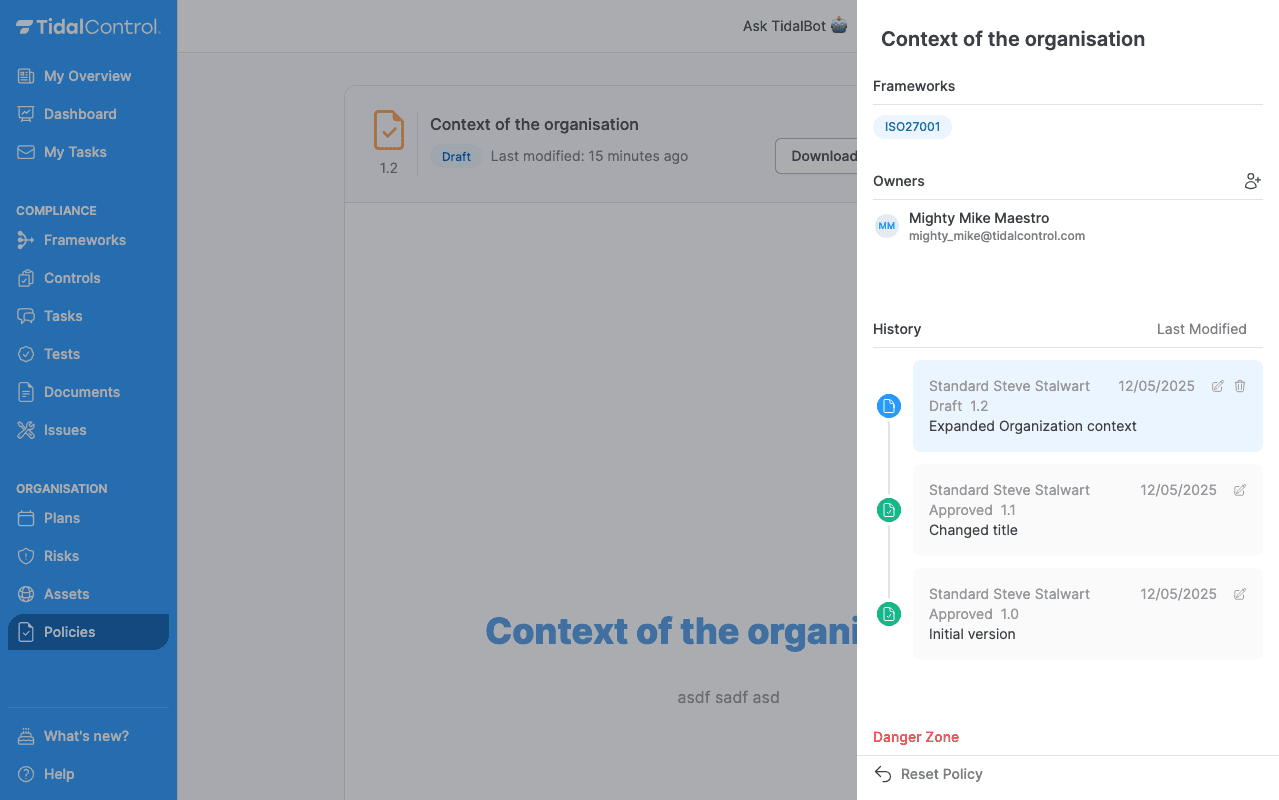
Assigning owner(s) via the Policy detail page
To assign owners to a specific policy:
- Go to a specific policy by clicking on the title
- Click the menu button (three horizontal lines) to open the sidebar
- Find the "Policy ownership" section in the sidebar
- Click the user icon to add an owner
- Select users from the available list
You can assign multiple owners to one policy. This is useful when different departments are responsible for different aspects of the policy.
Navigating version history
In the policy editor sidebar (three horizontal lines) you find the complete version history:
- Active version is marked in blue
- Click on a version to view it
- Draft versions can still be edited
- Approved versions are read-only
This function is useful to:
- Compare changes between versions
- Go back to an earlier version
- Check which version is currently active
Updating policy information
In the sidebar you can also check:
- Next review date - When the policy needs to be reviewed
- Linked frameworks - Which compliance frameworks are linked
- Change history - Complete audit trail of changes
Automatic review reminders: Tidal automatically sends notifications when policies are due for review. Set realistic review cycles to avoid overloading your team.
Editing changelog
For each version in the history you can:
- Click the pencil icon next to a version
- Edit the change comment to explain changes
- Adjust the version number if desired
- Save the changes
Editing changelog information does not affect the approval date or author of the document. It only helps in maintaining clear version information.
Best practices for policy writing
Structure and flow
- Start with context - Why does this policy exist?
- Define scope - Who and what does it apply to?
- Describe procedures - How is it executed?
- Specify responsibilities - Who does what?
- (optional) Explain monitoring - How is compliance controlled? - often not needed because Tidal handles compliance.
Language use
Clear and unambiguous:
- Use active instead of passive sentences
- Avoid jargon and technical terms where possible
- Define important concepts
Actionable content:
- Use verbs that indicate clear actions
- Specify deadlines and frequencies
- Give concrete examples where useful
Template consistency: If you manage multiple policies, develop a standard template with consistent sections and formatting. This makes it easier for users to find information and ensures professional appearance.